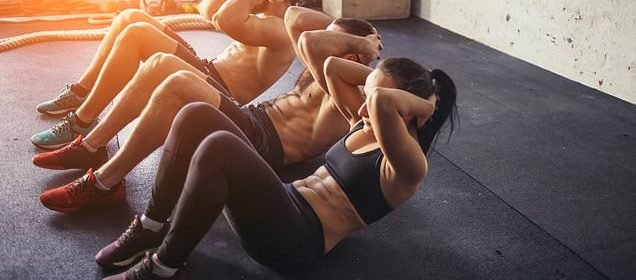How your personality could affect your favourite workout

How your personality could affect your favourite workout: Scientists discover sociable people choose CrossFit while sports players want recognition
- Researchers quizzed 400 people who prefer various types of exercise
- CrossFit trainers were the most motivated by social aspects
- They also came top for motivation from enjoyment and stress management
People’s motivations for exercising could influence which type of activity they’re most likely to get involved with, according to research.
Those who favour CrossFit are likely to be more motivated by being part of a group and also more motivated by their appearance than people who do other activities.
While health and fitness were generally the top motivations, the research showed differences in other aspects of people’s personalities.
Sports players and CrossFit trainers are the most likely to want social recognition and competition.
Weight lifters, on the other hand, have comparatively high levels of enjoyment compared to runners or people who do group yoga and spin.
The researchers said their findings show it is important for people to find an exercise programme which fits well with how they’re motivated.
People who do Crossfit exercise more than runners – and it could come down to the fact they are motivated by socialising, a study suggests
The research, by the University of Illinois, analysed what drives people to keep fit and their personality types to figure out their favourite workout.
Fitness lovers who go for CrossFit, sports, or group exercise were more highly motivated by socialising than those who run or lift weights, the study found.
They were also predicted to turn up more frequently, ranked highest in their motivation from enjoyment, stress management and the challenge.
Research has previously found that people’s personality, such as introvert or extrovert, indicates the exercise they chose, but this study found no link.
On the back of the findings, the team, led by Ms Allyson Box from the University of Illinois, said the choice of sport is cruicial for each individual’s success.
Ms Box, who began the work as an undergraduate student at Kennesaw State University, said: ‘Many individuals who initiate exercise programs may actually select activities that conflict with their interests, styles, personalities, and/or reasons for engagement.
‘Our findings support the need for individualized exercise programs, not only from a physical standpoint, but also from a motivational standpoint.
‘Taking these factors into account may impact the amount of physical activity/exercise that individuals actually complete.’
Data for the study, published in the journal Heliyon, were collected from more than 400 people who exercised and completed an online survey.
They were broken down into five groups: Crossfit; group training, such as yoga, spin or Zumba; aerobic training, such as long-distance running, cycling and swimming; resistance training, such as weight lifting; and athletic or team sport.
WHAT IS CROSSFIT?
CrossFit is a branded fitness regimen created by Greg Glassman that is often seen as a global ‘fitness cult’.
It is promoted as a health lifestyle that uses physical exercise and competitive fitness sport.
It incorporates elements from high-intensity interval training, Olympic weightlifting, plyometrics, powerlifting, gymnastics, girevoy sport, calisthenics, strongman, and other exercises.
According to a recent report from CNBC, “By the numbers, CrossFit is possibly the biggest fitness trend in the world. CrossFit has 13,000 gyms in more than 120 countries, up from just 13 in 2005.
Various fitness terms are used by Crossfitters including WOD, ‘Workout Of The Day’, and AMRAP, which is ‘as many rounds as possible’ of a certain move done in a given amount of time.
The Reebok CrossFit Games are held every summer in the US and draw thousands of people. Last year the Games gave out $2 million in prizes for competitors.
Personality factors, motives for participation, and self-control styles were assessed using widely accepted frameworks.
Their findings show that individuals selecting CrossFit, sports, or group exercise were more highly motivated by social connectedness, including social recognition, affiliation and competition.
Although everyone in the study was highly motivated to exercise to improve their health, those who did resistance training and sport were more motivated by a sense of challenge than ill-health avoidance or weight management.
Regardless of the exercise, most people were motivated for to stay healthy, feel strong and look good – with Crossfit ranking highest in interest in appearance.
People doing group exercises like classes were also among the most likely to be motivated by their appearance, and least likely to care about whether they enjoyed themselves or not.
But the study also demonstrated that people more motivated by reasons such as enjoyment, challenge and stress management exercised more frequently; CrossFit participants ranked highest in these.
The authors wrote: ‘Overall, it seemed that those who selected CrossFit training as their PMA (primary mode of physical activity) reported stronger motivation across the majority of participatory motives in comparison to the other PMAs.
‘This may be a result of the encompassing nature of CrossFit training, that is, it may fulfill motives for participation more broadly than other exercise modes.’
The scientists originally suggested that personality traits would determine how people preferred to get physical.
People who did group exercise, including Crossfit and sport, were expected to be more extroverted than those who work out alone. But this was not supported by the findings, the researchers said.
‘We encourage individuals to reflect on their personality and reasons for becoming physically active before diving into a physical activity program to ensure they engage in a physical activity that is compatible with their interest, personality, and goals,’ the authors said.
‘Our findings suggest that it may be more than just seeking the latest “fitness fad” or “new diet” in order to influence health outcomes; identifying individual characteristics and motivational factors will aid in developing an exercise program that individuals will stick to over a prolonged period of time, not just a few months.’
The NHS and Physical Activity Guidelines for Americans recommend adults aged 19-64 should do 150 minutes of weekly physical activity every week, which be 30 minutes on five days of the week.
More than a billion adults around the world are at risk of serious disease through lack of exercise, a recent study by the World Health Organisation (WHO) found.
As a result, they face an increased risk of heart and artery disease, Type 2 diabetes, dementia, and some cancers.
In the UK, 40 per cent of women and 32 per cent of men were insufficiently active in 2016.
Less than 20 per cent of the US population meet proposed Physical Activity Guidelines for Americans (2018).
HOW MUCH EXERCISE DO YOU NEED TO DO?
To stay healthy, adults aged 19 to 64 should try to be active daily and should do:
- at least 150 minutes of moderate aerobic activity such as cycling or brisk walking every week and
- strength exercises on 2 or more days a week that work all the major muscles (legs, hips, back, abdomen, chest, shoulders and arms)
Or:
- 75 minutes of vigorous aerobic activity such as running or a game of singles tennis every week and
- strength exercises on 2 or more days a week that work all the major muscles (legs, hips, back, abdomen, chest, shoulders and arms)
Or:
- a mix of moderate and vigorous aerobic activity every week – for example, 2 x 30-minute runs plus 30 minutes of brisk walking equates to 150 minutes of moderate aerobic activity and
- strength exercises on 2 or more days a week that work all the major muscles (legs, hips, back, abdomen, chest, shoulders and arms)
A good rule is that 1 minute of vigorous activity provides the same health benefits as 2 minutes of moderate activity.
One way to do your recommended 150 minutes of weekly physical activity is to do 30 minutes on 5 days every week.
All adults should also break up long periods of sitting with light activity.
Source: NHS
Source: Read Full Article
